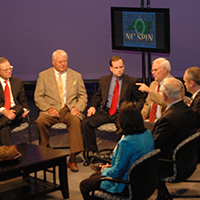Population growth and decline - we've got both in NC
Published January 7, 2015
by Doug Clark, Greensboro News-Record, January 7, 2015.
I’m a happy migrant to North Carolina, and I’m not alone.
“Since 1971, North Carolina has grown faster than the nation every year,” Rebecca Tippett, director of Carolina Demography at UNC-Chapel Hill, told me Monday.
That’s the year my family moved to North Carolina from New Jersey. It was a great move, initiated by my father’s transfer by Cannon Mills from its New York office to a knitting mill it owned in Maiden.
We could buy a bigger house for much less money in Hickory than the old home sold for up North. As far as commuting, Dad’s relaxing 20-minute drive through the country to Maiden was a breeze compared to riding a bus between the ’burbs and Manhattan every day.
My mother studied nursing at Western Piedmont Community College in Morganton and got a job in the infirmary at Lenoir-Rhyne College in Hickory. I attended UNC-Chapel Hill and my sister went to N.C. State, getting a good, low-cost education that wouldn’t have been possible in New Jersey.
North Carolina universities are still a big draw in their own right, according to Tippett. “We do get a lot of people moving to the state because of our universities,” she said.
North Carolina’s population in 1970 was 5,082,059. Last July, it reached 9,943,964, according to a U.S. Census Bureau estimate. Gov. Pat McCrory touted the latest annual increase of 95,047, which moved North Carolina past Michigan into ninth place in the country.
“The governor cited job creation, lower taxes and the state’s quality of life as some of the reasons for North Carolina’s growth,” a Dec. 23 press release from his office said.
Very good ... except, as you can see by the numbers for 1970 and 2014, North Carolina has averaged adding better than 110,000 people annually.
If you look at the past 25 years, you find even more impressive growth — 135,000 a year.
North Carolina achieved its growth peak of more than 200,000 a year less than a decade ago. Since then, growth has dropped steadily — 188,222, 156,602, 139,081. In each of the last four years, population growth has been less than 100,000 — low by North Carolina standards.
Has North Carolina lost its edge? Not necessarily. The growth rate is still one of the fastest in the country, which isn’t bad considering that job creation since the recession has been fair but not robust.
At the same time, North Carolina is experiencing some of the same demographic changes as the rest of the country, Tippett said: slowing migration, lower fertility and population aging (meaning more people are dying).
What distinguishes the United States from many countries in East Asia or Western Europe where populations have declined has been immigration. Yet, some parts of our country, and our state, are seeing people move away — not out of the country; just somewhere else.
While North Carolina continues to grow by nearly 100,000 people a year overall, dozens of counties are losing population — more than 30 such counties between 2010 and 2013, according to the Office of State Budget and Management.
North Carolina’s population gains over the decades coincide with increasing urbanization. Twenty percent of the state’s population now lives in just two counties — Wake and Mecklenburg. Wake County reached 1 million residents last year, and Mecklenburg is close behind. The state will hit the 10 million mark in population this year. Guilford County has about 500,000 residents. In 2010, two-thirds of North Carolina’s population lived in cities.
Many rural areas and small towns are falling behind. Not only are they losing population but, according to Tippett, they tend to lose their most productive residents — the people who can find jobs somewhere else. Bright young people leave for college and never return. There’s a downward spiral of both population and economic activity.
One possible remedy for declining rural areas is to attract retired people. They consume a lot of health care but pay for it. They also pay taxes but don’t have children in school, commit crimes or otherwise use a high share of public services.
On the other hand, many active seniors want urban amenities and first-class medical facilities.
Population shifts, up and down, present challenges for state and local governments. North Carolina has both. Just consider schools. Some counties can’t build them fast enough, while others can no longer fill the ones they have.
If you think it’s getting too crowded where you live, you can find plenty of places in North Carolina that are crying for people. Some might even welcome migrants from New Jersey.







